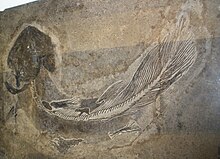Coelacanthus
| Coelacanthus Temporal range: Late Permian to Early Triassic
| |
|---|---|

| |
| Coelacanthus granulatus fossil | |
| Scientific classification | |
| Kingdom: | |
| Phylum: | |
| Class: | |
| Subclass: | |
| Order: | |
| Family: | |
| Genus: | Coelacanthus Agassiz, 1836
|
| Type species | |
| †Coelacanthus granulatus Agassiz, 1836
| |
| Other species | |
Coelacanthus ("Hollow Spine") is a genus of extinct coelacanths that first appeared during the Permian period. It was the first genus of coelacanths described, about a century before the discovery of the extant coelacanth, and the order Coelacanthiformes is named after it.
Description
Coelacanthus bears a superficial similarity to the living coelacanth Latimeria, though it was smaller, and had a more elongated head. Individuals grew up to 0.7 metres (2.3 ft) in length, had an elongate codavypter or supplementary tail lobe, and had small lobed fins, suggesting that Coelacanthus were open-water predators.

Distribution and time
The type species Coelacanthus granulatus was described from the late Permian (Wuchiapingian) of Germany and England. Coelacanthus is primarily known from Late Permian and Early Triassic deposits in Europe and Canada, although the referred species C. welleri, known from Iowa, is of Late Devonian (Famennian) age. It survived the Permian–Triassic extinction event, and one species, C. banffensis, is known from the Early Triassic.
Several other species that were first referred to Coelacanthus were later reallocated to other genera. Coelacanthus minor was considered by Woodward (1891) as potentially belonging to the Triassic genus Heptanema,[1] while Martin and Wenz (1984) considered Coelacanthus lunzensis a possible synonym of Garnbergia.[2] Coelacanthus madagascariensis from the Early Triassic of Madagascar was reattributed to the genus Rhabdoderma.[3]
References
- ^ Woodward A. S. 1891. Catalogue of the Fossil Fishes in the British Museum (Natural History). Part II. London.
- ^ M. Martin and S. Wenz. 1984. Découverte d'un nouveau Coelacanthidé, Garnbergia ommata n.g., n.sp., dans le Muschelkalk supérieur du Baden-Württemberg. Stuttgarter Beiträge zur Naturkunde Serie B (Geologie und Paläontologie) 105:1-17
- ^ Forey P. L. (1998) History of the coelacanth fishes (Chapman & Hall, London).
External links
Mikko's Phylogeny Archive on Coelacanthiformes





